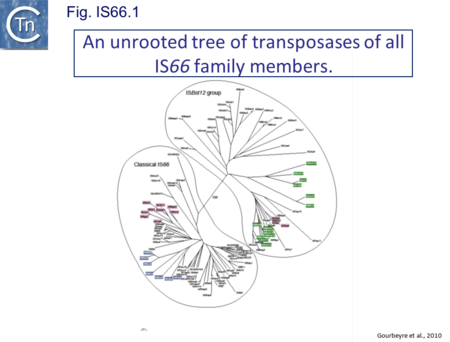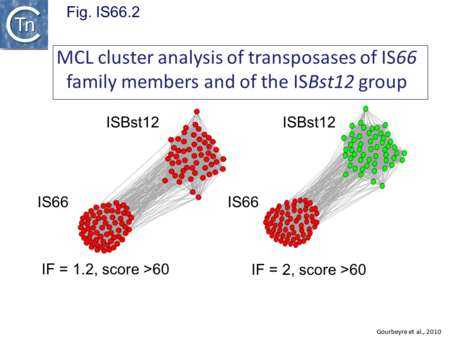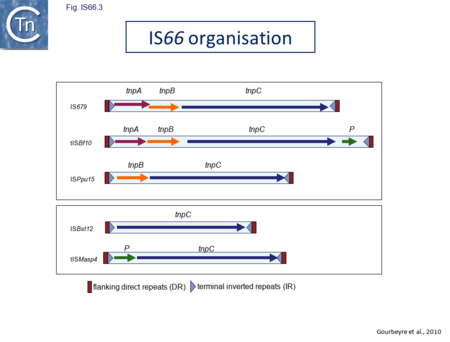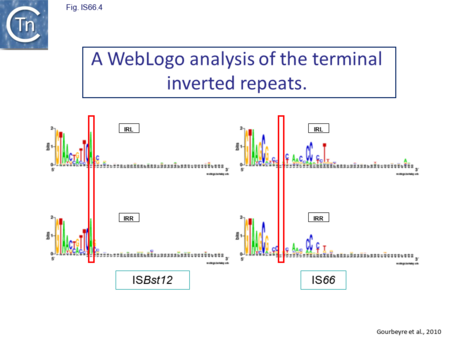Difference between revisions of "IS Families/IS66 family"
| Line 13: | Line 13: | ||
====Organization==== | ====Organization==== | ||
| − | The IS''66'' reference copy from a plasmid of the enteropathogenic ''Escherichia coli'' B171, IS''679'', �(��[11]� is defined by three ''orfs'' (Fig. IS66.3): ''tnp''A, ''tnp''B and ''tnp''C and relatively well conserved terminal IR of about 20-30 bp flanked by an 8 bp DR at their insertion sites (Fig. IS66.4). Orf ''tnp''C (Fig. IS66.5) is 1572 bp and its predicted product includes an N-terminal region with potential leucine zipper and zinc finger motifs (Fig. IS66.5; Fig. IS66.6a; Fig. IS66.7a) and a typical DDE motif (Fig. IS66.5; Fig. IS66.6b; Fig. IS66.7b; outlined in Fig. IS66.8). It also carries an insertion domain between the second D and the E of the DDE motif (e.g.IS''679,'' IS''Psy5 and'' IS''Mac8'') ���[12]� (see Fig.1.8.3) (Table Transposases examined by secondary structure prediction programs). | + | [[File:Fig IS66.4.png|left|thumb|450x450px|'''Fig IS66.4.''' The left (IRL) and right (IRR) inverted terminal repeats are shown in the WebLogo format (5). They are defined by the direction of transcription of the transposase gene. IRL, by definition, is located on the 5’ side of the transposase orf. For the number of sequences used in this analysis see Table S1.]] |
| + | The IS''66'' reference copy from a plasmid of the enteropathogenic ''Escherichia coli'' B171, IS''679'', �(��[11]� is defined by three ''orfs'' (Fig. IS66.3): ''tnp''A, ''tnp''B and ''tnp''C and relatively well conserved terminal IR of about 20-30 bp flanked by an 8 bp DR at their insertion sites (Fig. IS66.4). Orf ''tnp''C (Fig. IS66.5) is 1572 bp and its predicted product includes an N-terminal region with potential leucine zipper and zinc finger motifs (Fig. IS66.5; Fig. IS66.6a; Fig. IS66.7a) and a typical DDE motif (Fig. IS66.5; Fig. IS66.6b; Fig. IS66.7b; outlined in Fig. IS66.8). It also carries an insertion domain between the second D and the E of the DDE motif (e.g.IS''679,'' IS''Psy5 and'' IS''Mac8'') ���[12]� (see Fig.1.8.3) (Table Transposases examined by secondary structure prediction programs). | ||
The role of the products of ''tnpA'' (651 bp) and ''tnpB'' (345 bp) is less clear. TnpA carries a potential HTH motif (Fig. IS66.9) while TnpB shows no marked potential secondary structure motifs. Mutation of each ''orf'' separately (by introduction of an in-frame deletion) reduced transposition by at least two orders of magnitude ���[11]�. The three frames are disposed in a pattern suggesting translational coupling: ''tnpB'' is in general in translational reading frame -1 compared to ''tnpA'' and in most cases the termination codon of ''tnpA'' and the initiation codon of ''tnpB'' overlap (ATGA). An initiation codon for ''tnpC'' occurs slightly downstream separated from ''tnpB'' by about 20 bp. | The role of the products of ''tnpA'' (651 bp) and ''tnpB'' (345 bp) is less clear. TnpA carries a potential HTH motif (Fig. IS66.9) while TnpB shows no marked potential secondary structure motifs. Mutation of each ''orf'' separately (by introduction of an in-frame deletion) reduced transposition by at least two orders of magnitude ���[11]�. The three frames are disposed in a pattern suggesting translational coupling: ''tnpB'' is in general in translational reading frame -1 compared to ''tnpA'' and in most cases the termination codon of ''tnpA'' and the initiation codon of ''tnpB'' overlap (ATGA). An initiation codon for ''tnpC'' occurs slightly downstream separated from ''tnpB'' by about 20 bp. | ||
| Line 19: | Line 20: | ||
However, rather surprisingly, in the light of a requirement for all three ''orfs'' for transposition of the canonical IS''66'' family member IS''679'', members of the IS''Bst12'' group are devoid of ''tnpA'' and ''tnpB'' and carry only the ''tnpC'' reading frame. Although both IS''Bst12'' and IS''66'' members contain IRs which start with 5’GTAA3’, they are clearly distinguishable due to a single conserved A at bp 11 In IS''Bst12'' which is not conserved in IS''66'' (Fig. IS66.4; Table IS66.1). | However, rather surprisingly, in the light of a requirement for all three ''orfs'' for transposition of the canonical IS''66'' family member IS''679'', members of the IS''Bst12'' group are devoid of ''tnpA'' and ''tnpB'' and carry only the ''tnpC'' reading frame. Although both IS''Bst12'' and IS''66'' members contain IRs which start with 5’GTAA3’, they are clearly distinguishable due to a single conserved A at bp 11 In IS''Bst12'' which is not conserved in IS''66'' (Fig. IS66.4; Table IS66.1). | ||
| − | IS''66'' members can be grouped into three classes based on their organization: those including all three ''orfs'', A, B and C transcribed in the same direction; those with additional passenger genes invariably present downstream of ''orf''C and transcribed in the same direction; and those which lack ''orf''A but retain both ''orfs'' B and C (Fig. IS66.3; Table IS66.1). Each of these organizations includes members with multiple copies, implying that they are active in transposition. In addition to the DDE catalytic domain (Fig. IS66.5; Fig. IS66.6b; Fig. IS66.7b)���[4]�, TnpC also exhibits a highly conserved CwAH-rR motif downstream of the second D residue, a relatively conserved CX2(C)X33CX2C motif characteristic of a zinc finger (ZF) further upstream and a leucine-rich region which might form a leucine zipper (LZ) necessary in multimerisation of other Tpases �(Haren'', et al.'', 1998)�, at the N-terminus (Fig. IS66.5; Fig. IS66.6a; Fig. IS66.7a). | + | IS''66'' members can be grouped into three classes based on their organization: those including all three ''orfs'', A, B and C transcribed in the same direction; those with additional passenger genes invariably present downstream of ''orf''C and transcribed in the same direction; and those which lack ''orf''A but retain both ''orfs'' B and C (Fig. IS66.3; Table IS66.1). Each of these organizations includes members with multiple copies, implying that they are active in transposition. In addition to the DDE catalytic domain (Fig. IS66.5; Fig. IS66.6b; Fig. IS66.7b)���[4]�, TnpC also exhibits a highly conserved CwAH-rR motif downstream of the second D residue, a relatively conserved CX2(C)X33CX2C motif characteristic of a zinc finger (ZF) further upstream and a leucine-rich region which might form a leucine zipper (LZ) necessary in multimerisation of other Tpases �(Haren'', et al.'', 1998)�, at the N-terminus (Fig. IS66.5; Fig. IS66.6a; Fig. IS66.7a). |
| + | |||
| + | |||
| + | |||
| + | |||
| + | |||
| + | |||
| + | |||
| + | |||
| + | |||
=====A list of representative IS''66'' family members and the IS''Bst12'' group===== | =====A list of representative IS''66'' family members and the IS''Bst12'' group===== | ||
Revision as of 19:31, 7 June 2020
Contents
General
IS66 was first identified in the Ti plasmid pTi66 of Agrobacterium tumefaciens Sciaky �[1,2]� and, soon after in the symbiotic plasmid, pSym, of Rhizobium fredi �[3]�. The vast majority of IS66 members originate from the Proteobacteria with several from the Bacteriodetes/Chlorobi and the Firmicutes. A second group of closely related ISs, widely spread among both bacteria and archaea are thought to represent a sub-group within the IS66 family �[4]�. These are relatively well distributed (Fig. IS66.1). The founder member, ISBst12, originally isolated from Bacillus stearothermophilus, was described as a novel family �(��[5]�, but identification of many additional examples suggests that the ISBst12 and IS66 groups should be considered a single family (Fig. IS66.2). Several examples of IS derivatives with passenger genes have been identified (Fig. IS66.3; Table IS66.1). One important example is a potential tIS in which IRL is located downstream from an MCR-3 (colistin resistance) gene �[6]�). Members of the ISBst12 group are found in Actinobacteria, Cyanobacteria, Deinococcus/Thermus, Firmicutes, and Planctomycetes as well as in Proteobacteria. They are also found in the Euryarchaeota phylum of archaea (but have not yet been identified in the Crenarchaeota).



Genome Impact
IS66 was first identified in the Ti plasmid pTi66 of Agrobacterium tumefaciens Sciaky [1,2] and, soon after in the symbiotic plasmid, pSym, of Rhizobium fredi [3]. The vast majority of IS66 members originate from the Proteobacteria with several from the Bacteriodetes/Chlorobi and the Firmicutes. A second group of closely related ISs, widely spread among both bacteria and archaea are thought to represent a sub-group within the IS66 family [4]. These are relatively well distributed (Fig. IS66.1). The founder member, ISBst12, originally isolated from Bacillus stearothermophilus, was described as a novel family ([5], but identification of many additional examples suggests that the ISBst12 and IS66 groups should be considered a single family (Fig. IS66.2). Several examples of IS derivatives with passenger genes have been identified (Fig. IS66.3; Table IS66.1). One important example is a potential tIS in which IRL is located downstream from an MCR-3 (colistin resistance) gene [6]). Members of the ISBst12 group are found in Actinobacteria, Cyanobacteria, Deinococcus/Thermus, Firmicutes, and Planctomycetes as well as in Proteobacteria. They are also found in the Euryarchaeota phylum of archaea (but have not yet been identified in the Crenarchaeota).
Organization

The IS66 reference copy from a plasmid of the enteropathogenic Escherichia coli B171, IS679, �(��[11]� is defined by three orfs (Fig. IS66.3): tnpA, tnpB and tnpC and relatively well conserved terminal IR of about 20-30 bp flanked by an 8 bp DR at their insertion sites (Fig. IS66.4). Orf tnpC (Fig. IS66.5) is 1572 bp and its predicted product includes an N-terminal region with potential leucine zipper and zinc finger motifs (Fig. IS66.5; Fig. IS66.6a; Fig. IS66.7a) and a typical DDE motif (Fig. IS66.5; Fig. IS66.6b; Fig. IS66.7b; outlined in Fig. IS66.8). It also carries an insertion domain between the second D and the E of the DDE motif (e.g.IS679, ISPsy5 and ISMac8) ���[12]� (see Fig.1.8.3) (Table Transposases examined by secondary structure prediction programs).
The role of the products of tnpA (651 bp) and tnpB (345 bp) is less clear. TnpA carries a potential HTH motif (Fig. IS66.9) while TnpB shows no marked potential secondary structure motifs. Mutation of each orf separately (by introduction of an in-frame deletion) reduced transposition by at least two orders of magnitude ���[11]�. The three frames are disposed in a pattern suggesting translational coupling: tnpB is in general in translational reading frame -1 compared to tnpA and in most cases the termination codon of tnpA and the initiation codon of tnpB overlap (ATGA). An initiation codon for tnpC occurs slightly downstream separated from tnpB by about 20 bp.
However, rather surprisingly, in the light of a requirement for all three orfs for transposition of the canonical IS66 family member IS679, members of the ISBst12 group are devoid of tnpA and tnpB and carry only the tnpC reading frame. Although both ISBst12 and IS66 members contain IRs which start with 5’GTAA3’, they are clearly distinguishable due to a single conserved A at bp 11 In ISBst12 which is not conserved in IS66 (Fig. IS66.4; Table IS66.1).
IS66 members can be grouped into three classes based on their organization: those including all three orfs, A, B and C transcribed in the same direction; those with additional passenger genes invariably present downstream of orfC and transcribed in the same direction; and those which lack orfA but retain both orfs B and C (Fig. IS66.3; Table IS66.1). Each of these organizations includes members with multiple copies, implying that they are active in transposition. In addition to the DDE catalytic domain (Fig. IS66.5; Fig. IS66.6b; Fig. IS66.7b)���[4]�, TnpC also exhibits a highly conserved CwAH-rR motif downstream of the second D residue, a relatively conserved CX2(C)X33CX2C motif characteristic of a zinc finger (ZF) further upstream and a leucine-rich region which might form a leucine zipper (LZ) necessary in multimerisation of other Tpases �(Haren, et al., 1998)�, at the N-terminus (Fig. IS66.5; Fig. IS66.6a; Fig. IS66.7a).
A list of representative IS66 family members and the ISBst12 group
Table IS66.1. The table summarises from left to right: the IS name; group defined in the MCL analysis; accession number; host from which it was identified; kingdom (archaea, A, or bacteria, B); phylum; organisation (org) A,B,C,P show the presence of TnpA, TnpB, TnpC and Passenger genes respectively; length of the IS in base pairs (bp); length of the terminal inverted repeats (IR); length of flanking direct repeats (DR); number of examples identified in the host genome.
| IS name | Group | Accession Number | Host | A/B | G+/G- | Org. | Length (bp) | IR (bp) | DR (bp) | N° |
|---|---|---|---|---|---|---|---|---|---|---|
| IS66-1 | - | AF242881 | Agrobacterium tumefaciens | B | G- | ABC | 2556 | 18/20 | 8 | 2 |
Mechanism and Insertion Specificity
Nothing is known about the transposition mechanism of this group of IS and they exhibit no substantial target sequence specificity.